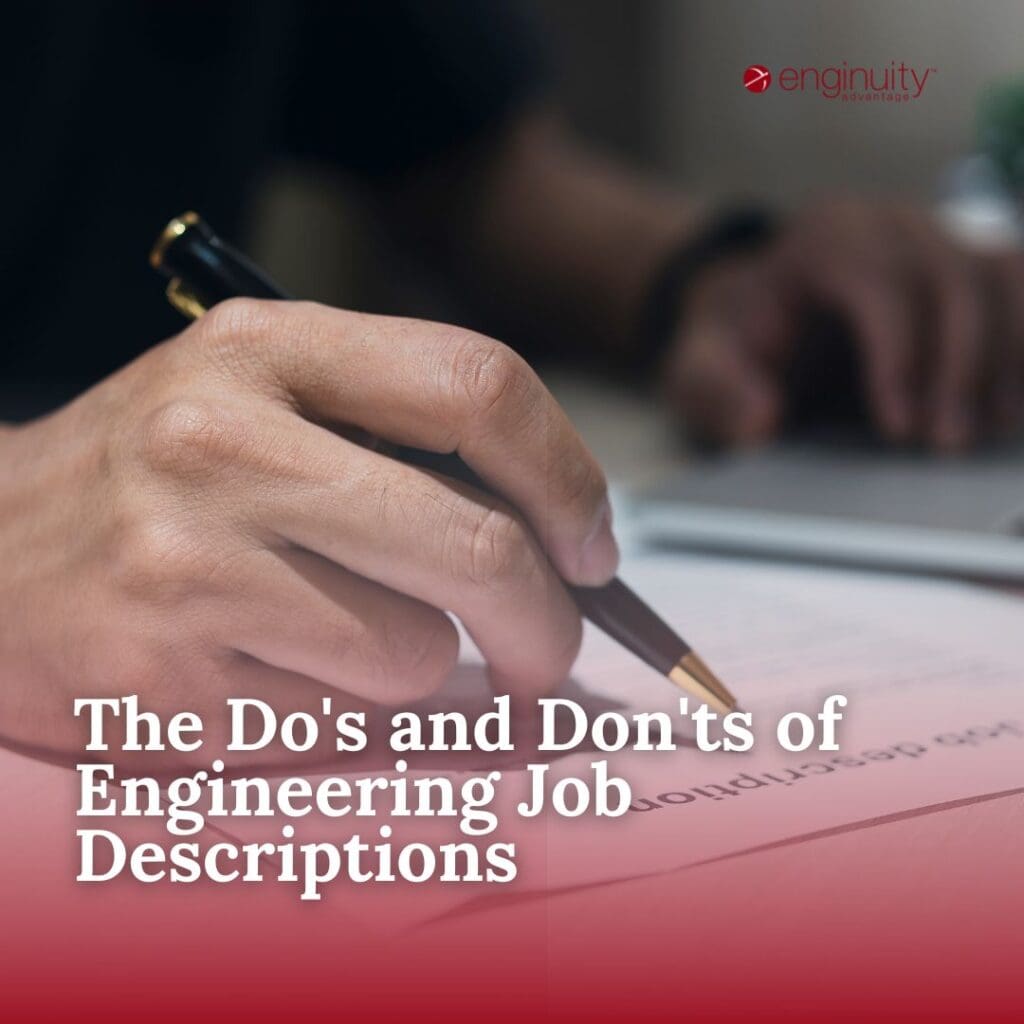The Do’s and Don’ts of Engineering Job Descriptions

In today’s engineering job market, 77% of employers worldwide are finding it difficult to fill open job roles, which represents a 17-year-high talent shortage. The creation of an effective job description has never been more crucial. A job description serves as more than just a notice of vacancy—it’s a pivotal component of your hiring strategy, acting as both a filter and a beacon to attract the kind of talent that doesn’t just fill a role but elevates the entire team.
It’s an engineered recruitment tool precision-designed to captivate top-tier candidates—those who not only check the technical boxes but also resonate with the firm’s cultural and strategic blueprint.
For engineering companies, constructing a job description is an exercise in clarity and persuasion. It should illuminate the role’s impact, not just through a list of duties but by articulating the position’s place within the company’s grand design.
In specifying the role’s intricacies with accuracy and passion, engineering firms can streamline their candidate selection process. This sharpens the recruitment funnel, encouraging self-selection among prospects and ensuring those who apply are more likely to fit the company’s cultural weave. 79% of job seekers use a company’s job description as their leading tool for gauging company fit.
An effectively composed job description does more than signal a job opening; it magnetizes the right talent. For engineering firms, this means attracting individuals who are not just technically adept but are also primed for engagement, innovation, and a harmonious fit with the firm’s visionary journey. It’s a vital gear in the machinery of building a team equipped to propel the company into its next phase of growth.
Here’s a no-nonsense guide to constructing job descriptions that hit the mark.
Want the ultimate posting guide from our hiring experts for free? Click Here to Download.
Do: Start with a Clear Job Title
The job title should be instantly recognizable. Avoid creative titles that can confuse job seekers. For instance, use “Environmental Compliance Engineer” instead of vague titles like “Compliance Guru.” Clear titles improve the searchability of your job posting across job boards and search engines.
Don’t: Overwhelm with Responsibilities
While it’s crucial to detail the job responsibilities, a laundry list can overwhelm prospects. Prioritize the top five responsibilities that carry the most weight. Candidates usually don’t want to read a novel when they click your job post. Most will spend just 14 seconds deciding whether or not to apply, so it’s important to make your posts easily scannable. That explains why short job posts (1-300 words)tend to do much better than medium (301-600 words) or long (601+ words) ones—convincing candidates to apply 8.4% more often than average.
Do: Detail Required Qualifications
Be explicit about must-have qualifications versus nice-to-haves. This clarity helps candidates self-filter, saving time for all parties involved. If “Professional Engineer (PE) licensure” is non-negotiable, state it upfront.
Don’t: Neglect Soft Skills
Technical prowess in areas like “advanced computational fluid dynamics” or “expertise in sustainable urban development” is essential, but so are soft skills. In a survey, 67% of HR managers reported they’d hire a candidate with strong soft skills even if technical skills fell short, as they value potential for growth.
Do: Illustrate with Metrics
Quantify expectations. For example, “drive project completion with a 20% improvement in efficiency” or “reduce system downtimes by 30%.” Concrete numbers help candidates understand the scope and scale of their potential impact.
Don’t: Use Internal Jargon
Every company has its lingo, but your job description should be universally understood. Phrases familiar only to current employees can alienate outsiders. Instead of saying “must be proficient in CompanyX standards,” specify the actual industry-standard skills required.
Do: Outline the Application Process
A clear application process sets expectations and can increase the number of completed applications. Let candidates know if they should expect proficiency tests, multiple interview stages, or any presentations. Transparency is key.
Don’t: Forget About Diversity
Emphasize your commitment to a diverse workforce. Over 76% of job seekers actively seek out employers with cultures that focus on workplace diversity,. If your company is an “Equal Opportunity Employer,” make sure it’s known.
Do: Promote Your Employer Brand
A compelling employer brand can reduce hiring costs by up to 50%. Share what makes your company unique. Perhaps it’s your innovative “use of AI in civil engineering” or your commitment to “green technologies in electrical engineering projects.”
Don’t: Be Inflexible with Requirements
Rigid requirements can deter great candidates who might lack one specific skill but are otherwise perfect. Instead, focus on what candidates will learn and how they’ll grow. For example, “Gain expertise in leading-edge seismic retrofitting techniques.”
By doubling down on these do’s and don’ts, your job descriptions will not only draw in candidates with the right skills and experience but also those who will thrive in your company culture, contribute to your projects, and grow with your firm.
But writing that perfect job description is only half the battle. The next step? Partnering with a team who understands the intricate needs of the engineering sector and can help you find those standout candidates who are ready to contribute to your company’s success from day one.
If you’re ready to elevate your talent acquisition and land the professionals who will power your company’s future, we’re here to help. Don’t let your next engineering superstar slip through the cracks. Contact us now and let’s build your dream team together.
Unlock Dream Careers & Elite Talent: Just One Click Away!



